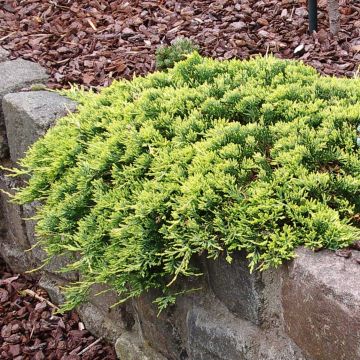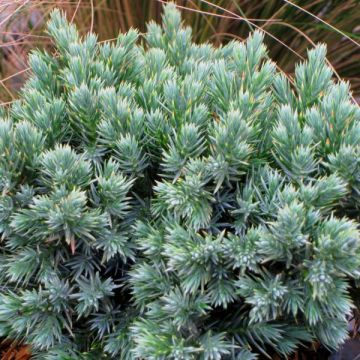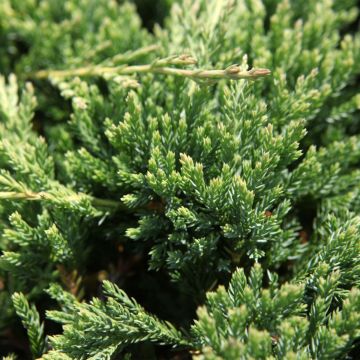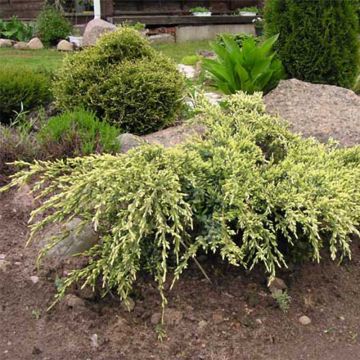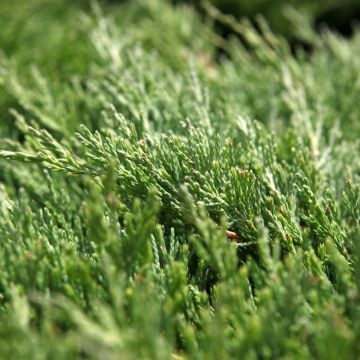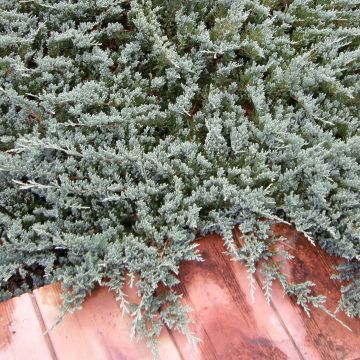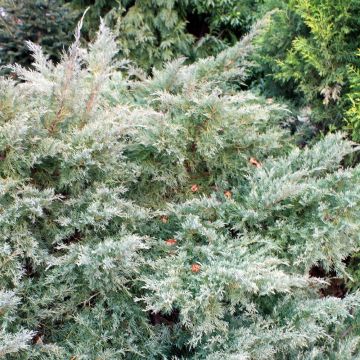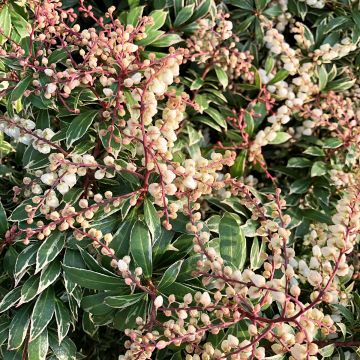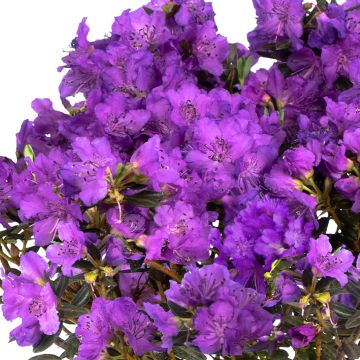

Juniperus squamata Golden Flame
Juniperus squamata Golden Flame
Juniperus squamata Golden Flame
Flaky Juniper, Himalayan Juniper
Why not try an alternative variety in stock?
View all →This plant carries a 24 months recovery warranty
More information
We guarantee the quality of our plants for a full growing cycle, and will replace at our expense any plant that fails to recover under normal climatic and planting conditions.
From €5.90 for pickup delivery and €6.90 for home delivery
Express home delivery from €8.90.
Delivery to Corse prohibited: UE law prohibits the import of this plant from mainland France to Corse as part of the fight against Xylella fastidiosa. Please accept our sincere apologies.
More information
Does this plant fit my garden?
Set up your Plantfit profile →
Description
Juniperus squamata 'Golden Flame' is a variety of scale-like juniper that is interesting for its variegated foliage and moderate growth. It is a conifer with a moderate development and spreading habit, well-branched, with foliage that displays two contrasting colours in spring. Its cream-yellow young shoots appear on green-blue needles with grey highlights. It is perfect for covering a slope, filling a rock garden, or adding volume to a large bed. Hardy, undemanding, and highly ornamental.
The scale-like juniper, also known as Nepalese juniper, gets its common name from its old needles that it keeps at the base of the branches. It is a conifer species native to the mountains of the Himalayas and China, where it grows at an altitude between 1600 and 4900 m. Extremely cold-resistant (down to -30°C), it tolerates some limestone but does not like heatwaves. All cypresses belong to the Cupressaceae family.
Juniperus squamata 'Golden Flame' is sometimes sold under the name Juniperus squamata 'Blue Star Variegated', although its habit is more reminiscent of the 'Meyeri' variety. It has a slow growth rate, reaching a maximum height of 1.70 m and a spread of 2.60 m. Its habit is bushy, spreading, slightly irregular, supported by angled branches. Its branches bear numerous short and rigid shoots, adorned with small, tightly packed and overlapping leaves. The foliage is green-blue-silvery from summer to winter, contrasting with the light yellow spring growth. Junipers have a shallow root system, which often makes them difficult to associate with perennials.
The 'Golden Flame' juniper will be highlighted on a slope or in a large rock garden that is not too dry. It can also be placed above a wall or low wall, or near a swimming pool, as it goes well with geometric lines. It can also be planted near a water feature, overlooking a rocky scree. It can be paired with other dwarf conifers of different shapes or colours, as well as with ornamental grasses and heathers that complement it well. The key is to play with volumes and colours. The architectural qualities of conifers are essential in the design of a contemporary garden, which emphasizes the aesthetics of shapes, silhouettes, and textures. These plants, with their reassuring permanence, provide long-lasting structure to a bed, mark pathways, and border terraces.
Tips: Water regularly during the first two years, and in case of prolonged drought. While it can tolerate occasional dry soil in a cool climate, this mountain conifer will be disappointing in a Mediterranean climate, which is too dry and hot in summer.
Report an error about the product description
Plant habit
Foliage
Safety measures
Botanical data
Juniperus
squamata
Golden Flame
Cupressaceae
Flaky Juniper, Himalayan Juniper
Juniperus squamata 'Blue Star Variegated'
Cultivar or hybrid
atteinterespiratoire
Cette plante peut entraîner des symptômes allergiques.
Evitez de la planter si vous ou vos proches souffrez de rhinite saisonnière ("rhume des foins").
Davantage d'informations sur https://plantes-risque.info
Other Juniperus - Juniper
Planting and care
Juniperus squamata 'Golden Flame' thrives in mountain climates and is sensitive to arid conditions and heatwaves. It should be planted from September to November in well-drained soil that retains moisture, even if it is poor and slightly chalky, in a very sunny location. If your soil is too heavy, a small trick is to plant your bush on a mound and mulch it with gravel. Water regularly during the first two years, especially during prolonged dry spells. Soak the root balls thoroughly before planting. Apply organic fertiliser at the time of planting and water generously during the first few years. Fertilise the soil in April using a special conifer fertiliser and hoe the soil in summer. This hardy conifer dislikes heavy soils that become waterlogged in winter. Pruning is not necessary, but this conifer can be pruned to maintain a beautiful habit or to limit its size.
Planting period
Intended location
Care
This item has not been reviewed yet - be the first to leave a review about it.
Evergreen shrubs
Haven't found what you were looking for?
Hardiness is the lowest winter temperature a plant can endure without suffering serious damage or even dying. However, hardiness is affected by location (a sheltered area, such as a patio), protection (winter cover) and soil type (hardiness is improved by well-drained soil).

Photo Sharing Terms & Conditions
In order to encourage gardeners to interact and share their experiences, Promesse de fleurs offers various media enabling content to be uploaded onto its Site - in particular via the ‘Photo sharing’ module.
The User agrees to refrain from:
- Posting any content that is illegal, prejudicial, insulting, racist, inciteful to hatred, revisionist, contrary to public decency, that infringes on privacy or on the privacy rights of third parties, in particular the publicity rights of persons and goods, intellectual property rights, or the right to privacy.
- Submitting content on behalf of a third party;
- Impersonate the identity of a third party and/or publish any personal information about a third party;
In general, the User undertakes to refrain from any unethical behaviour.
All Content (in particular text, comments, files, images, photos, videos, creative works, etc.), which may be subject to property or intellectual property rights, image or other private rights, shall remain the property of the User, subject to the limited rights granted by the terms of the licence granted by Promesse de fleurs as stated below. Users are at liberty to publish or not to publish such Content on the Site, notably via the ‘Photo Sharing’ facility, and accept that this Content shall be made public and freely accessible, notably on the Internet.
Users further acknowledge, undertake to have ,and guarantee that they hold all necessary rights and permissions to publish such material on the Site, in particular with regard to the legislation in force pertaining to any privacy, property, intellectual property, image, or contractual rights, or rights of any other nature. By publishing such Content on the Site, Users acknowledge accepting full liability as publishers of the Content within the meaning of the law, and grant Promesse de fleurs, free of charge, an inclusive, worldwide licence for the said Content for the entire duration of its publication, including all reproduction, representation, up/downloading, displaying, performing, transmission, and storage rights.
Users also grant permission for their name to be linked to the Content and accept that this link may not always be made available.
By engaging in posting material, Users consent to their Content becoming automatically accessible on the Internet, in particular on other sites and/or blogs and/or web pages of the Promesse de fleurs site, including in particular social pages and the Promesse de fleurs catalogue.
Users may secure the removal of entrusted content free of charge by issuing a simple request via our contact form.
The flowering period indicated on our website applies to countries and regions located in USDA zone 8 (France, the United Kingdom, Ireland, the Netherlands, etc.)
It will vary according to where you live:
- In zones 9 to 10 (Italy, Spain, Greece, etc.), flowering will occur about 2 to 4 weeks earlier.
- In zones 6 to 7 (Germany, Poland, Slovenia, and lower mountainous regions), flowering will be delayed by 2 to 3 weeks.
- In zone 5 (Central Europe, Scandinavia), blooming will be delayed by 3 to 5 weeks.
In temperate climates, pruning of spring-flowering shrubs (forsythia, spireas, etc.) should be done just after flowering.
Pruning of summer-flowering shrubs (Indian Lilac, Perovskia, etc.) can be done in winter or spring.
In cold regions as well as with frost-sensitive plants, avoid pruning too early when severe frosts may still occur.
The planting period indicated on our website applies to countries and regions located in USDA zone 8 (France, United Kingdom, Ireland, Netherlands).
It will vary according to where you live:
- In Mediterranean zones (Marseille, Madrid, Milan, etc.), autumn and winter are the best planting periods.
- In continental zones (Strasbourg, Munich, Vienna, etc.), delay planting by 2 to 3 weeks in spring and bring it forward by 2 to 4 weeks in autumn.
- In mountainous regions (the Alps, Pyrenees, Carpathians, etc.), it is best to plant in late spring (May-June) or late summer (August-September).
The harvesting period indicated on our website applies to countries and regions in USDA zone 8 (France, England, Ireland, the Netherlands).
In colder areas (Scandinavia, Poland, Austria...) fruit and vegetable harvests are likely to be delayed by 3-4 weeks.
In warmer areas (Italy, Spain, Greece, etc.), harvesting will probably take place earlier, depending on weather conditions.
The sowing periods indicated on our website apply to countries and regions within USDA Zone 8 (France, UK, Ireland, Netherlands).
In colder areas (Scandinavia, Poland, Austria...), delay any outdoor sowing by 3-4 weeks, or sow under glass.
In warmer climes (Italy, Spain, Greece, etc.), bring outdoor sowing forward by a few weeks.



































